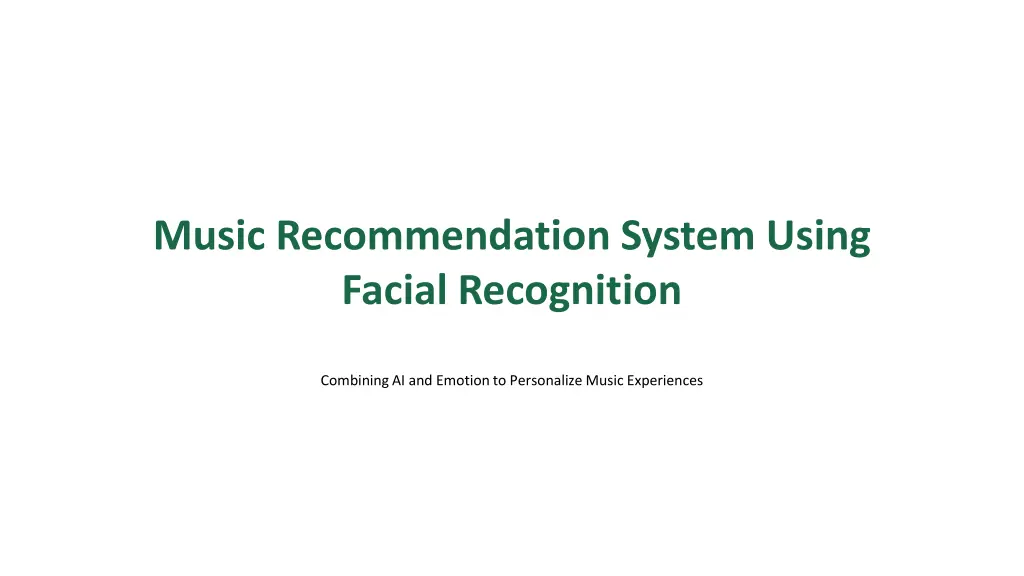
Personalized Music Experiences Through Facial Recognition and Emotion Detection
Explore how a Music Recommendation System leverages facial recognition technology and artificial intelligence to personalize music suggestions based on users' emotions. By combining AI with emotion detection, this system offers a dynamic way to curate music experiences that resonate with users on an emotional level, enhancing user engagement and satisfaction.
Download Presentation

Please find below an Image/Link to download the presentation.
The content on the website is provided AS IS for your information and personal use only. It may not be sold, licensed, or shared on other websites without obtaining consent from the author. If you encounter any issues during the download, it is possible that the publisher has removed the file from their server.
You are allowed to download the files provided on this website for personal or commercial use, subject to the condition that they are used lawfully. All files are the property of their respective owners.
The content on the website is provided AS IS for your information and personal use only. It may not be sold, licensed, or shared on other websites without obtaining consent from the author.
E N D
Presentation Transcript
Music Recommendation System Using Facial Recognition Combining AI and Emotion to Personalize Music Experiences
01 Introduction to Music Recommendation Systems Table of Contents 02 The Role of Facial Recognition in Music Why We Combine AI and Emotion in Music Recommendations Recommendations 03 04 The Process of Emotion Detection 05 Mapping Emotions to Music 06 User Experience and Engagement 07 Technological Considerations 08 Future Prospects 09 Conclusion 10 Thank You!
1 Introduction to Music Recommendation Systems A music recommendation system suggests tracks based on user preferences and behavior, enhancing user engagement with personalized playlists. These systems analyze data such as listening history and preferences to provide tailored recommendations. They improve user experience by introducing new music aligned with listeners' tastes. Incorporating AI, these systems learn continuously to refine suggestions over time. This presentation explores the integration of facial recognition into music recommendation.
2 The Role of Facial Recognition in Music Facial recognition technology identifies individuals by analyzing unique facial features, a significant advancement in AI. It verifies identity and enables applications across security, retail, and now, music technology. Facial recognition can detect emotions by interpretingexpressions, essential for understanding users' moods. This creates opportunities for music recommendations that resonate with users emotionally. Integrating this technology offers a dynamic way to curate music experiences.
3 Why We Combine AI and Emotion in Music Recommendations Emotions play a crucial role in how we connect with music; we often seek tracks that reflect or alter our moods. Studies show that music significantly impacts emotional states, making it a powerful tool for well-being. By analyzing facial expressions, we can better understand users' immediate emotional context. This personalization fosters deeper connections between users and music, enhancingsatisfaction. An emotional approachto recommendations can transform user interaction with music.
4 The Process of Emotion Detection The system starts by detecting users' faces using cameras integratedwith the application. It captures facial data in real-time to assess emotional states happy, sad, surprised, or relaxed. AI algorithms process these expressions, identifying emotions with high accuracy. This analysis occurs instantly, allowing for real-time music recommendations based on mood. The effectiveness of this system relies on continuous learning and data processing.
5 Mapping Emotions to Music Each detected emotion has a correspondingmusic style or genre that matches its mood. For example, happiness may link to upbeat pop, while sadness might correspond with mellow acoustic tracks. This mapping is crafted from extensive research on music psychology and user preferences. The system dynamically updates its libraryto expand genres and styles as it learns from user interactions. Creating this bridge between emotions and music enriches user experience.
6 User Experience and Engagement Personalized music experiences increase user satisfaction, making apps more engaging and enjoyable. Recommendations based on currentemotions lead to a unique, immersive experience in music consumption. Users often feel more connected to music that reflects their moods, enhancing emotional well-being. Facial recognition innovations can attract more users to music apps looking for tailored experiences. Ultimately, this approach can foster loyalty among users.
7 Technological Considerations Implementing facial recognition requires attention to privacy and ethical guidelines to protect user data. Transparency about data usage and emotion analysis is crucial for user trust. Technical aspects include robust AI models and efficient algorithms for processing facial data. Applications must also ensure seamless integration with existing music recommendation engines. Navigating these challenges is essential for successful implementation.
8 Future Prospects The convergence of AI, facial recognition, and music is still in its infancy, presenting vast opportunities. Future developments may include more nuanced emotion recognition and broadergenre connections. Potential for live music experiences that adapt in real-time to audience emotions. Collaborations across tech and music industries can fuel innovation in this field. Continued advancements will lead to richer, more engaging user experiences.
9 Conclusion The integration of facial recognition into music recommendation systems represents a significant leap. By considering users' emotional states, we can create tailored music experiences that resonate. Personalization is key to enhancing user engagement and satisfaction in music consumption. As technology evolves, so too will the possibilities for innovative music experiences. Thank you for exploring this exciting intersection of AI and music!
10 Thank You! Thank you for joining this presentation on music recommendation systems and facial recognition. Your insights and questions are welcome as we continue to explore this innovative field. Feel free to reach out for furtherdiscussion or collaboration.
